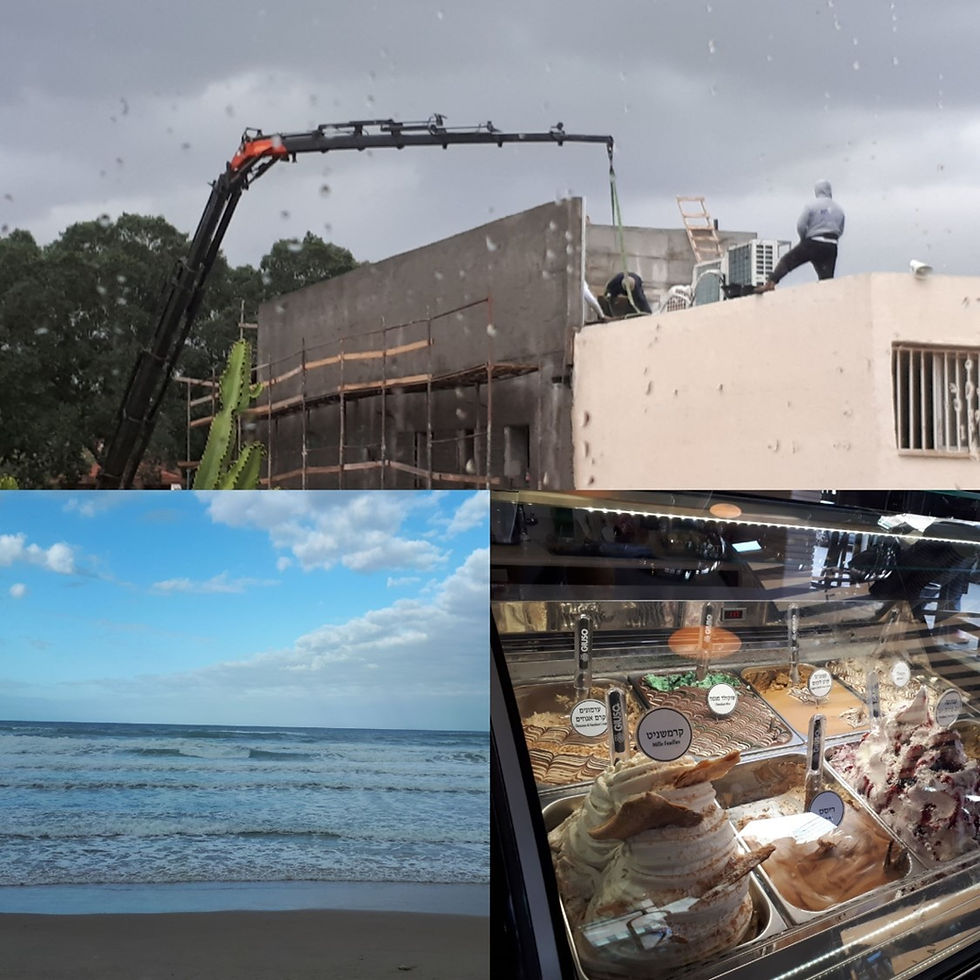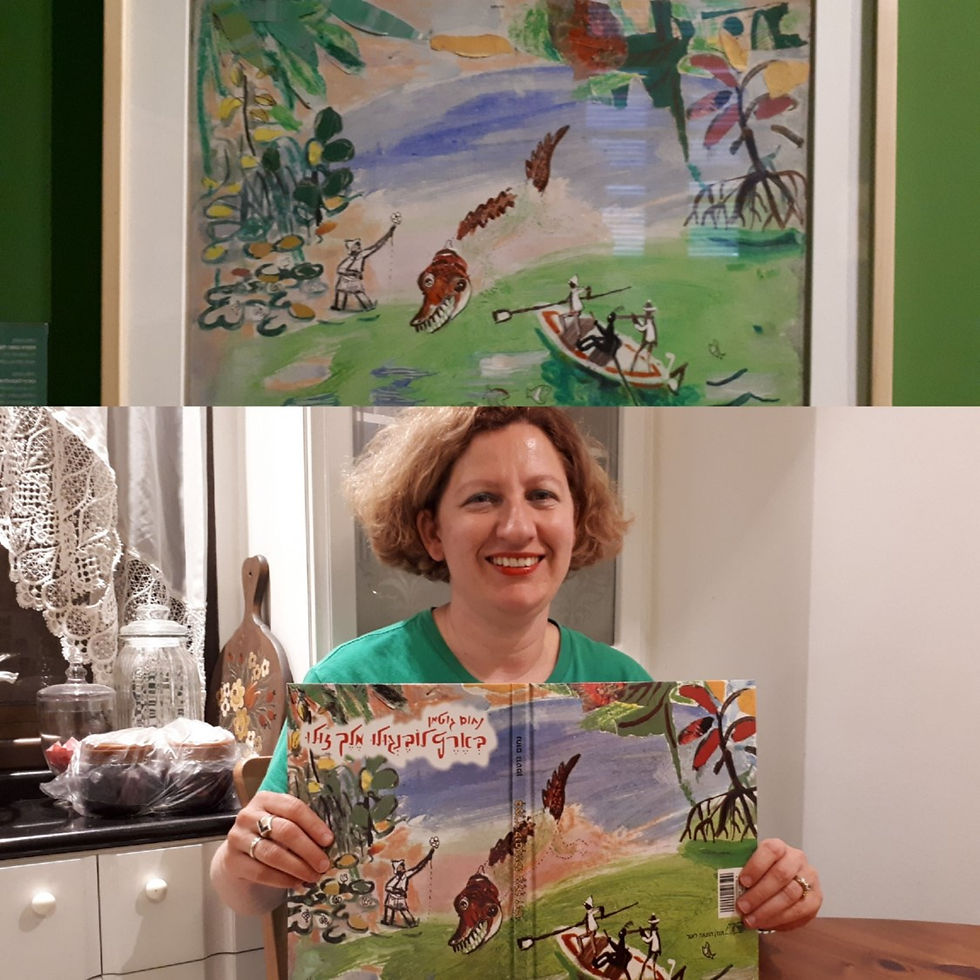Hi there!
After a rainy outlook as determined from my window (top photo), this trip turned out better than I had thought possible (bottom photos). I even had some salted cashew ice-cream, which I forgot to take a picture of! This trip runs through the first Jewish neighborhood to be built outside of Old Jaffa in the late 19th century, called ‘Neve Zedek’. It is one of the prettiest neighborhoods of Tel-Aviv, because a lot of the old houses underwent preservation to their original Bauhaus beauty.

Fortunately, interspersed within this beautiful background, are a few Israeli Ministry of Defense museums, which are all interesting and good for you to become aware of before our upcoming 70th Independence Day. I was happy to find out that a combination ticket for five museums is offered and is valid for one month. It includes entry, but does not include the audio-guides. Not that it is expensive, but you may be happy to know that on Independence Day, entry into all Ministry of Defense museums is free of charge. Lastly, you need to bring valid photo ID such as a passport with you. I visited two this time and will write a future post on the other three. Oh, and I included a few other stops too.
Trip Itinerary Options:
The 1947-1948 Etzel Museum - Beit Gidi
Mitcham Hatachana
Israeli Defense Forces (IDF) History Museum
Suzanne Dallal Center
Aharon Chelouche House
Aboulafia and Shai Agnon House – Currently Hava and Dani Ronat Gallery
Nachum Gutman Museum
'Beit Rokach' Museum
Trip Anchors:
The IDF History Museum is an open-air museum because the display includes large weapons interspersed between cabins that exhibit the smaller ones. Another interesting aspect is, that it includes several authentic historic pieces that participated in actual operations as well as political gifts given to prime ministers, ministers of defense and chiefs of staff. The museum encompasses the period from the British Mandate till more contemporary times. This museum is particularly suitable for children because it is more tangible even though they are not allowed to touch or climb the exhibits. The museum is easily self-guided with an audio-guide.

The ‘Etzel’(1931-1948) was one of the paramilitary revisionist Zionist groups. The visit includes a film and several displays pertaining to the organization’s main operations between the UN’s partition plan on Nov 29, 1947 up until the establishment of the State of Israel and its absorption into the IDF.
However, the best feature in the museum is Mr. Yosef Nachmias, a former Etzel fighter who volunteers at the museum each day. He should be 94 today and he’s a still a tough cookie, true to his generation, yet totally adorable. He wasn't in when I visited this time because I came very early in the morning, but the photo below was taken two years ago on Independence Day after hearing him give a remarkable speech.

The museum itself is built in one of the old houses that was partially hit during the 1948 fighting in Jaffa. It is right on the boardwalk and you can see Old Jaffa to your south and the rest of Tel-Aviv’s coastline to your north. You can read about my post on ‘Old Jaffa’ for another trip idea here, if you haven’t already.

Nachum Gutman (1898-1980), was one of the first artists in Tel-Aviv. He was a painter, sculptor, writer and illustrator and was awarded the Israel Price in 1978. I personally love his colorful paintings and especially enjoyed seeing in the museum, the original paintings of one of his children’s books that I have at home “In the Land of Lobengulu, King of Zulu”. The museum is located in what used to serve as a home to writers and is one of the original buildings in the neighborhood. It has three sections, one exhibiting Nachum Gutman’s works, one exhibiting contemporary artists and one with exhibits for children, which may even be fun for non-Hebrew speaking children because it has games and activities some of which are possible to understand even without understanding Hebrew (drawing, memory games, dressing up etc.). It isn’t a perfect fit, but it could be ok.

Additional Options
This is one of the locations where you should stop for a light meal. ‘Mitcham Hatachana’ translates literally into the ‘bounded area of the station’ because it used to be the first train station of the line leading from Jaffa, the western stop, to Jerusalem. The train line ran between 1892-1948. It was dismantled during the Independence War, but a few years ago underwent preservation and rejuvenation turning it into a lovely recreational are with pretty boutiques, restaurants and cafes. There is a 3D film and simulator of a train there for children and there is a fair in the area every Friday at 10:00 for locally made crafts. The second meal stop will be in one of the restaurants or cafés within ‘Neve Zedek’. Go to the food section below for a list of places in each.

After you get out of Mitcham Hatachana and the IDF History Museum, you cross the nearby playground and start walking into the ‘Neve Zedek’ neighborhood. The Suzanne Dallal Center is now a theater and home to the ‘Batsheva’ and ‘Inbal’ dance companies. Aside from checking out what shows are scheduled, it is just a pretty place to see. The two buildings in the center used to be a school for boys, where they taught in French and a school for girls, where they taught in Hebrew (related to where the funding was coming from), which led to some boys studying in the girls’ school including Nachum Gutman, whose gallery you can visit later. The ceramic mural depicts the ‘Neve Zedek’ neighborhood’s beginning.

Aharon Chelouche House
The house on 32 Chelouche St. was undergoing reconstruction at the time of my visit so I didn’t take a picture, but if you come in the future, you’ll be able to stop by and see it. Aharon Chelouche, was one of the founders of the neighborhood, a leader of the Sefaradic community whose house was the first one built. At one time his house served as the synagogue, which is now to the south of the house. His sons opened a cement factory and built several of the houses in the neighborhood and his grandson Moshe Chelouche was the third mayor of Tel-Aviv in 1936.
Beit Aboulafia and Shai Agnon – Currently Hava and Dani Ronat Gallery
The house on 2 Shimon Rokach St. belonged to Shlomo Aboulafia, the great-grandson of Rabbi Chaim Aboulafia from Tiberias. He was a founder of the neighborhood, serving also as Mukhtar representing the neighborhood during the Ottoman period. He was also a teacher of French and Arabic in the schools that you saw in Suzanne Dellal. One of the rooms in his house was let to Nobel Laureate writer Shmuel Yosef (Shai) Agnon between 1909-1912. The story is that Shai Agnon fell for Margalit from the Chelouche family since her house was opposite his window, but when he approached her uncle Rabbi Eliyahu Chelouche to request approval to go out with her, he was rejected for being a poor Ashkenazi good for nothing who wastes his time on writing. Another story is that the Arab domestic worker changed his name to Aboulafia after the owner died, out of respect and later opened a bakery that is famous today in Jaffa.
I went to see the house and found that it is now the home and gallery of a married couple, Hava and Dani, who are both artists. They are both proficient in glass fusion techniques and have on display a variety of glass works such as jewelry (Hava), stained glass windows and lamps (Dani) and more. Hava was so sweet that when I told her I was a new travel blogger, she agreed to a Selfie together in order to help me. I'm sure she would be delighted if you come visit her gallery.

The house on 21 Rokach St. belonged to one of the founders of the neighborhood, Shimon Rokach. As an public activist, he founded a number of associations such as ‘Bnei Zion’ and ‘Ezrat Israel’ in order to assist the needy and immigrant Jews living in Jaffa. He also founded the ‘Pardes’ association representing the citrus growers in Israel and managed it for 20 years. His son, Yisrael Rokach was mayor of Tel-Aviv between 1936-1952. The house was the grandest house in the neighborhood at the time. It was designed by an Austrian architect and originally had a copper dome. Today, his granddaughter Lea Majaro-Mintz, a painter and sculptor, born in the second half of the 1920s lives there. The house is open only on Thursday, Fridays and Saturdays. The written material and film are available in English, but the re-enactment plays that they have are only in Hebrew.

Food
Restaurants and cafés in ‘Mitcham Hatachana’ include: ‘Vicky Christina’, ‘Vaniglia’, ‘Café Greg Hatachana’ and ‘Cafe Hatachana’.
Restaurants and cafés in ‘Neve Zedek’ include: ‘Okinawa’, ‘Beccafico’, 'Meshek Barzilay', ‘Suzana Restaurant’, 'Dallal', ‘Epicerie Fine Neve Zedek’, ‘Mama Lulu’, ‘Bellini’, ‘Dellal Bakery’, ‘Anita Café La Mama Del Gelato’, ‘Neve Zedek – A Place for Meat’ and ‘Nina Café Bistro’.
Accomodation:
Nearby accommodation in Neve Zedek includes: ‘Nina Café Suites Hotel’, ‘Boutique Molcho Neve Zedek’, ‘Levy Hotel’, ‘Trieste Neve Zedek Boutique Suites’, ‘Brown TLV Urban Hotel’, ‘Intercontinental David Tel-Aviv’, ‘The Varsano Hotel’, ‘Villa Vilina Oasis in Neve Zedek’, ‘Neve Tzedek Hotel’.
My timeline:
The options here took me a day.
This is what it looks like on the map:

I enjoyed seeing the amount of groups in the various Israeli Ministry of Defense Museum undergoing educational activities. It was nice. What did you enjoy most?
Best,
Talma
P.S. If you're interested in travel-related offers, you're welcome to view my 'guided tours' and 'best deals' pages. Subscribers also have 'members only' benefits. To subscribe.
Disclaimer: The blog may contain affiliate links. If you purchase something through these links, I will receive a small percentage of the profits at no extra cost to you. Thank you for supporting Israel-Best-Trips.com
